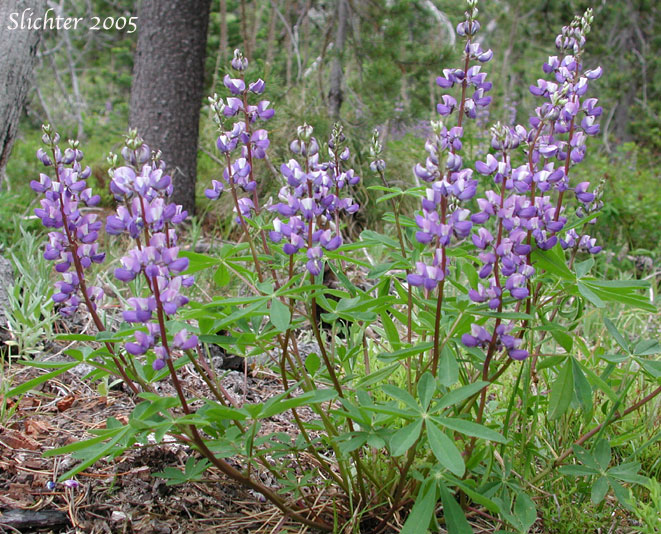The photo at left shows a close-up of the flower
of broadleaf lupine in dry, sandy soils at the base of Potato Hill, to the north
of Mt. Adams at the boundary between the Gifford Pinchot NF and Yakama Indian
Reservation..............June 21, 2005. The middle photo shows the open raceme of broadleaf
lupine in dry, sandy soils at the base of Potato Hill, to the north of Mt. Adams
at the boundary between the Gifford Pinchot NF and Yakama Indian Reservation.........June
21, 2005. The flowers of this species appear to be ranked, with clusters of
flowers arising in a whorl at approximately the same point on the stem. The at right shows broadleaf lupine in dry,
sandy soils at the base of Potato Hill, to the north of Mt. Adams at the boundary
between the Gifford Pinchot NF and Yakama Indian Reservation..........June
21, 2005. Although similar in appearance to
large-leaf
lupine (
Lupinus polyphyllus) or
Lupinus burkei,
this species is typically found in drier, sandier soils and has leaves with
a smaller diameter, and racemes that are typically more open.
This photo shows a sample of broad-leaf lupine lacking blue pigment so that the flower has pink or lavender-tinged keel and wing petals. Normal-flowered individuals as well as a fully non-pigmented (white-flowered) individual were also seen at this site. North rim of Outlet Creek in the Klickitat Canyon Community Forest......June 9, 2022.
The photos above show various views of a young broadleaf lupine as seen along Road #23 on private lands next to a clearcut just south of the Gifford Pinchot N.F. boundary on the south side of Mt. Adams.........June 2, 2007.
Broadleaf lupine observed just east of the Klickitat Breaks, Klickitat Wildlife Area.......May 26, 2020.
Broadleaf lupine in bloom in open coniferous forest along the Willard Springs Trail, Conboy Lake National Wildlife Refuge.....May 16, 2022.
Broadleaf lupine observed in bloom in oak forest along roads east of Canyon Creek, Klickitat Wildlife Area.......May 13, 2025. Note the unusual split tip to the raceme at right.
The photos above show close-ups of what appears to be broadleaf lupine as seen along Lakeside Road in Conboy Lake NWR...........June 21, 2008. The plants at this location, and across the east to west gradient of the refuge show great variablilty in their appearance. Many have unbranched stems, and numerous appressed haris atop the leaflets. Some have ciliated keels while others do not.
 -
-  -
- 